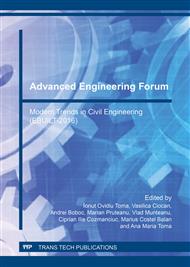p.460
p.468
p.474
p.482
p.489
p.497
p.506
p.514
p.520
Thermal Modeling of Thermo-Active Systems in Subway Tunnels: A Chilean Case Study
Abstract:
Since the mid 80’s thermo-active structures have been used around the world to take advantage of shallow geothermal energy. However, these systems have just been considered as energy options in Chilean projects. In this article we explore the design, numerical modeling, and thermal behavior of a flat heat exchanger integrated to the concrete wall of a subway tunnel in Chile. The thermo-active structure is the concrete tunnel wall (energy tunnel) that has an arrangement of circular pipes with water as the heat carrier fluid. Such a system has a low-cost installation, because pipes are embedded in the concrete tunnel wall during construction. The numerical modeling considers actual environmental conditions in the tunnel and the surrounding ground properties. The considered operating condition is restricted to heat transfer from the air within the tunnel and from the surrounding ground to the heat carrier. We studied the dependency of heat absorption on the heat carrier flow rate, and on the spacing of pipe arrangements. Results predict that a 10-meter section of tunnel can capture up to 6.900W in winter and 10.300W in summer. Most heat (75%) is extracted from the air within the tunnel, which allows a reduction of the tunnel air temperature of 5°C during winter and of 8°C during summer. Thus, implementing such a system has a dual effect of cooling the tunnel (a desired outcome) and providing a source of cheap thermal energy.
Info:
Periodical:
Pages:
489-496
Citation:
Online since:
March 2017
Authors:
Price:
Сopyright:
© 2017 Trans Tech Publications Ltd. All Rights Reserved
Share:
Citation:


